Submitted by: Maureen Schimnowsky, Gallery Assistant
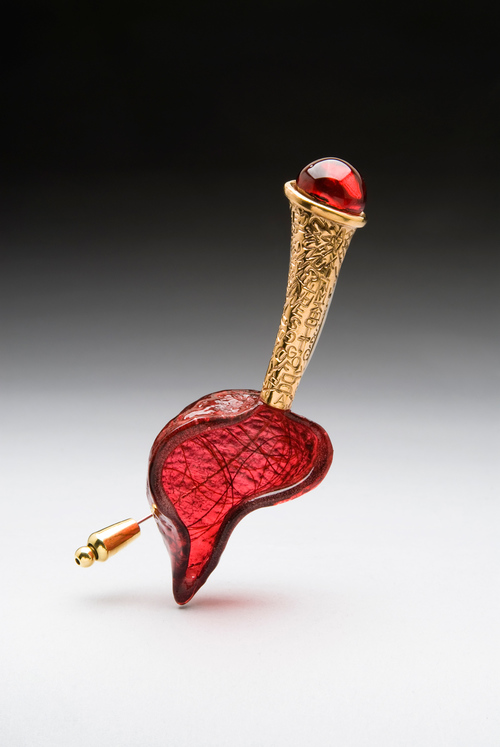
Voiceless, a brooch from Mary Lynn Podiluk’s collection Metalanguage. Source.
When I first found out that I had been accepted to the Nova Scotia College of Art and Design (NSCAD) in 2009, I had the excitement and paralyzing fear that accompanies finding out you’re about to move away from home for the first time – to a university that’s over 4000 kilometers away. My older brother was particularly excited, telling me “You have to talk to my friend! She’s out in Halifax attending her first year at NSCAD right now!” A few emails later, and I was in touch with Mary Lynn Podiluk, then a jewellery student at the Nova Scotia College of Art and Design. She was more than willing to send me as much information as she could; long emails full of tips and tricks and a promise that I already had a friend on the coast. In the years that followed, not only was I able to get to know Mary Lynn as an Irish Music Session aficionado, nature enthusiast, talented gardener and incredible cook, I also had the opportunity to witness Mary Lynn’s artistic practice from the Maritimes to back home again.
Between listening to amazing Irish music sessions around pub tables, and sampling her unbelievably delicious chocolate banana bread, I also observed Mary Lynn in her studio space. I remember stopping by the jewellery studio at some inhumane hour of the evening (possibly morning) just as Mary Lynn’s husband was dropping off some Tupperware containers full of left overs, knowing that she would be there the rest of the night and well into the next day. Her dedication and love for her artistic practice was apparent, as continually demonstrated by her innovative sculptural jewellery pieces, and the unique resin casting technique that she has developed.
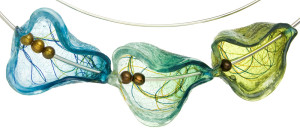
A close up of Mary Lynn’s piece Echo. Source.
For those unfamiliar with Nova Scotia, the Maritimes have a distinct and flourishing glass and crystal blowing culture. While NSCAD itself doesn’t presently offer classes in glass blowing, it is difficult to wander the streets of Halifax and not be constantly reminded of this beautiful art form. Mary Lynn cites glass blowing and artists like Dale Chihuly as inspirations in her practice, yet she readily admits that glass was not her first choice when it came to her own pieces, despite the likeness between her resin cast forms and blown glass. This is partly because Mary Lynn operates within a set frame of weight parameters, which is one of the distinctions between whether a piece might be considered functional jewellery or a more conceptually based sculptural form. Not only would glass in lieu of resin make her pieces too heavy to wear comfortably, but much of the beauty of Mary Lynn’s pieces comes from the gravity-defying, almost ethereal quality of the resin weightlessly suspended on its wire or metallic form; something that the heaviness of glass would be incapable of replicating. The resilience of resin is another huge draw — unlike the fragility of glass, it is easier to create larger, more sculptural jewellery that continues to look and feel delicate despite the heartiness of the resin.
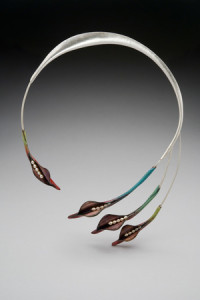
Florescence, part of Mary Lynn’s collection Botanica, investigates forms found in nature. Source.
This ability to look like glass, while proving to be stronger and lighter than its more fragile counterpart, is particularly important when considering the inspiration behind much of Mary Lynn’s body of work. Having taken classes in linguistics at the University of Saskatchewan before heading out to the Maritimes, Mary Lynn’s passion for language and the human body is recognizable in many of her pieces. As stated on her website, “The resin forms appear to emit sound, and the silver traces its path. Uniting language inspired design, rich colour, and organic texture and form, my jewellery bridges multiple senses, inviting the viewer to experience sound in a visual and tactile way.” Mary Lynn’s endeavour to represent concepts as intangible as language by creating wearable, sculptural forms is no small feat, yet the photo galleries on her website show she is doing just that.
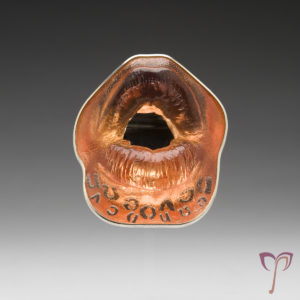
Created in 2011, AEIOU and Sometimes Y is a brooch that further explores the nuances of language. Source.
It’s little wonder that the versatility of resin lends itself so well to Mary Lynn’s designs, however patient one must be in order to create such gossamer-like forms. Once the original concept and shape is decided upon (often the inspiration comes directly from the mirror-like relationship between the human body and objects found in nature), the next step is creating the piece in real life. On top of a combined process of hand carving closed molds, and techniques similar to glass blowing/sculpting, the resin itself can take upwards of fifty hours to cure completely, even after Mary Lynn is finished setting the resin’s shape. This slow, detail oriented process is what makes each of Mary Lynn’s pieces so unique. Her dedication to creating non-replicable pieces of jewellery is rewarded by the originality and care that gives each piece it’s own, almost human, essence.
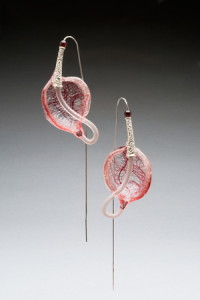
Breath, a pair of earings from Mary Lynn’s collection Metalanguage. Source.
As all Craftspeople are aware, it’s easy to see how a day spent in the studio can so easily transform into a day and a night (… and another day …) while the perfect form is taking shape. If you’re interested in trying your own hand at resin casting, check out these sites for tutorials — Craftbits, Resin Obsession, Brit+Co — and for some inspiration — The Pendant Emporium, Underglass, Froze Nature.
Mary Lynn’s work has received a number of accolades and has been exhibited nationally and internationally. She was named a winner in both the 2013 and 2015 NICHE Awards. In 2013, Mary Lynn presented a solo exhibition at Ottawa’s L.A. Pai Gallery — an opportunity granted for winning the 9th Annual National Jewellery Student Competition in 2012. During the spring & summer of 2013, she represented Saskatchewan in The Canadian Mosaic of Metal in Toronto, ON. Mary Lynn had pieces chosen for both the 2013 and 2015 Dimensions touring exhibitions, and won awards in both of those exhibitions.
Mary Lynn Podiluk’s work can be found in the SCC Fine Craft Boutique, and viewed on her website: www.marylynnpodiluk.com
